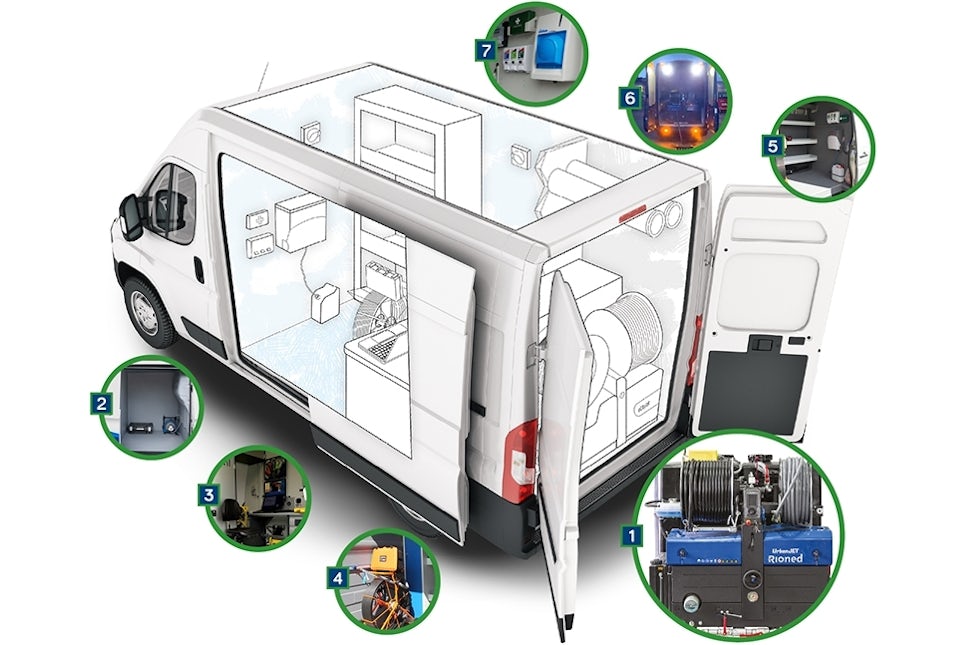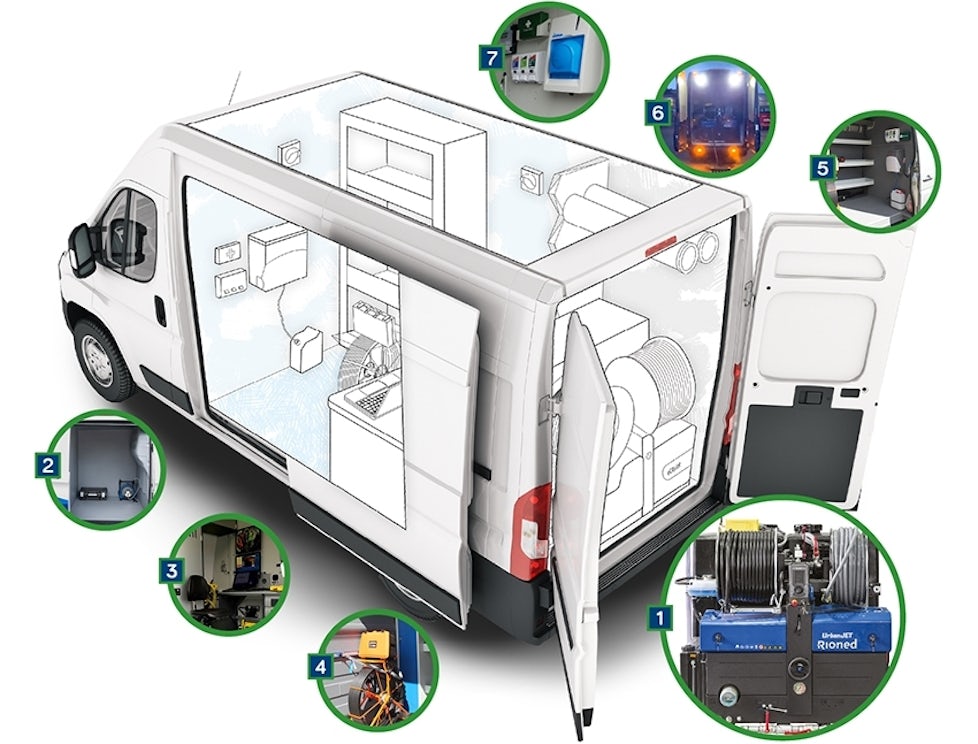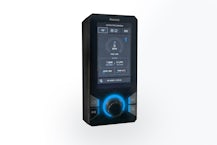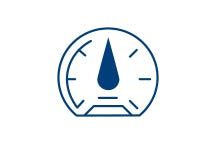- Guides
A Guide to Modern Van-pack Jetters and Jetting Vehicles

Contractors increasingly recognise the economic and environmental benefits of single-resolution operations. But carrying the requisite equipment for undertaking drain cleaning, surveying, testing and repair in a single visit requires a stripped-back approach, particularly in 3.5t vans – the most popular choice of vehicle in the UK drainage industry.
Weight is paramount in provisioning vehicles for single-visit operations. Modern drainage vans utilise a range of materials and features to optimise the weight of the vehicle whilst improving the efficiency and safety of engineers.
This guide has been compiled to offer an overview of the key considerations when provisioning a van-pack vehicle. We hope it provides food for thought.
Contents

| URBANJET Diesel or Petrol | CITYJET Diesel, Petrol or PTO | eCITYJET All-electric |
|---|---|---|
 |  |  |
The new UrbanJet is ideally suited for use in domestic and light commercial drains up to 300mm. Compact and lightweight, it can be installed in most makes of 3.5t vans. TYPICAL CAPACITIES | The CityJet is our flagship product with thousands of users worldwide. The all-new Stage V compliant diesel offers the performance and features our customers know and trust. TYPICAL CAPACITIES | The new all-electric eCityJet has been called ‘the future of drain cleaning’. Offering the performance and features of a conventional jetter, it produces zero emissions. TYPICAL CAPACITIES |
| UrbanJet Specification | CityJet Specification | eCityJet Specification |
2. JETTER FEATURES
As jetting equipment has become lighter the range of features have evolved.
In choosing a high-pressure water jetting machine, the key consideration should be the type of sewer or drain lines that need to be cleared, specifically in terms of length and diameter. As a rule of thumb, longer lines and larger diameter pipes require higher water flow to clean effectively and efficiently. It’s also paramount to understand the type of cleaning needed and choosing the right nozzles for the task can be considered as important as the equipment used.
The health and safety of users have been a driving factor in the development of drain jetting equipment. Modern high-pressure jetters include a range of features designed to ensure the safety of engineers in the field and the rising popularity of single-man operations has accelerated this change. The use of leader hoses to provide a visual reference to the position of the hose in the drain is nothing new but features such as hose meterage counters, water pressure regulators and remote control units have further enhanced the safety of jetters.

A. High-pressure Pump
The jetter engine generally powers the high-pressure water pump to produce water under pressure. Modern direct-drive triplex plunger pumps offer smooth, continuous water flow and pressure. Integrated pressure unloaders enhance pump protection and prolong its lifecycle.
B. Hydraulic Hose Reel
Hydraulic freewheel systems significantly reduce the effort required to operate a hose reel. A pivoting hose reel allows easier access to drain openings and the addition of a hose reel locking mechanism further improves operator safety.
C. Management System
Operator safety and efficiency is enhanced by a central control unit, often with an LCD screen, that provides information such operating hours, service warnings, liquid levels and hose distance at a glance.
D. Remote Control
Wireless remote-control systems enable engineers to work more efficiently, safely and with greater control. Modern dual-band remote control kits allow pressure and flow settings to be finely tuned for improved results and savings on running time and water usage.
E. Pulsator System
A pulsator operates by partially interrupted the water flow, creating a pulsing action on the hose which minimises hose drag enabling it to be propelled further and faster into the pipe. It also makes easier for the hose to navigate tight turns and clear stubborn blockages. The pulsator system also saves up to 30% in water usage, meaning operators can work longer with the same amount of water.
F. System Protection
Modern high-pressure jetters feature a number of components designed to reduce potential damage to the machine and extend its lifecycle. These typically include run-dry protection systems, unloader valves, and anti-freeze systems and tanks.
G. Lightweight Hoses
The latest lightweight high-pressure sewer hoses have a smooth inner surface and widened inner core to optimise the flow while significantly reducing resistance and pressure loss. Tests have shown these types of hoses increase effective working pressure at the nozzle by over 10%.
3. VAN LINING MATERIALS
The choice of vehicle lining and storage materials is important in keeping down the weight of vehicles. Often this involves using composite materials and spray linings rather than plywood.
Materials and benefits include:
- Spray Linings: Most often a two-part polymer/catalyst spray system that provides a tough, airtight, water-resistant non-slip surface without loss of cargo space.
- Composite Boards: Lightweight polypropylene boards often made up of several layers for extra thermal resistance and strength. Strong, flexible and 50% lighter than plywood, these materials of becoming increasingly popular.
- Aluminium Checker-plate: Probably the most durable lining material and often used in jetting vans. It has a disadvantage of being heavier and therefore adds additional weight to the vehicle.
4. INVERTER INSTALLATIONS
Power inverters that convert the vehicle’s battery power (DC) power into alternating current (AC) are an important asset in drainage vehicles. Many of the electrical tools used by contractors operate with 110v or 240v AC power, which is only possible with an inverter running off the vehicle’s DC battery supply. These include:
- CCTV inspection cameras and monitors
- Plug-in power tools and machines
- Recharging batteries
- Heaters
- Refrigerators
5. ANCILLARY EQUIPMENT
Contractors often need to carry a wide range of additional tools, including smaller drain cleaning machines, inspection monitors and cameras, detection devices, drain rods, relining kits and safety equipment.
- Small drain cleaning machines
- Inspection monitors and cameras
- Detection devices
- Drain rods
- Relining kits
- Safety equipment and PPE
| EXAMPLES OF RIONED ANCILLARY EQUIPMENT | |||
|---|---|---|---|
 |  |  |  |
| RioFlex | MiniJet | FiberCam+ | RioTrack Pro |
The new RioFlex high-speed flexible shaft drain cleaning machine has been designed for the rapid removal of rust, cement, lime, and small tree roots in concrete, cast iron, and PVC drains up to 125 mm. | The MiniJet is a high pressure jetting machine for residential- and light commercial use. Equipped with a silent and powerful electric motor and professional pump it is ideal for cleaning drains from 25 to 100 mm. | The FiberCam+ is a robust camera that works very well in larger drains and sewers. It is suitable for drains from Ø 70 – 300 mm. | The RioTrack Pro is a detection device that effortlessly detects 512 Hz and 33 kHz transmitters. In addition, this detector helps to detect power and radio cables. |
6. STORAGE OPTIONS
Vehicle weight distribution affects road-handling and fuel-efficiency. Water tanks and storage units can be positioned to distribute weight while providing ample storage for a range of tools and equipment. Storage solutions include:
- Pipe tubes
- Metal racking and shelving
- Storage lockers
- Heated lockers (for PPE and clothes)
- Monitor desks and drawer arrangements
7. LIGHTING
When working at night or in bad light, a well lit working area is best for both productivity and safety. There is a wide range of lighting options for van-pack vehicles, mostly utilising efficient, low-energy LED lights. These include:
- Internal lamps and lightbars
- External work lamps and lightbars
- Flashing beacons
- Directional warning lamps and lightbars
8. HEALTH & SAFETY
Now more than ever it is important to protect workers and customers against bacterial contamination. On-board welfare stations are a key component of this and can include:
- Hand wash units
- Eyewash stations
- First aid kits
- Fire extinguishers and blankets
9. BUYING EQUIPMENT
At Rioned we offer a full turnkey service to provide the vehicle, jetter, conversion work, vehicle branding and financing. We work closely with van suppliers, vehicle conversion specialists and finance companies to ensure the best outcomes.
Comprehensive finance plans are available for jetting equipment, vans and wide range of vehicle customisations and ancillary drainage equipment. Plans have been designed to help customers purchase business-critical equipment, with options such as low-start payments, zero deposits and VAT deferred packages.
For more information about vehicle and equipment finance please contact the sales team on 03300 240404 or visit our finance page
- Guides












